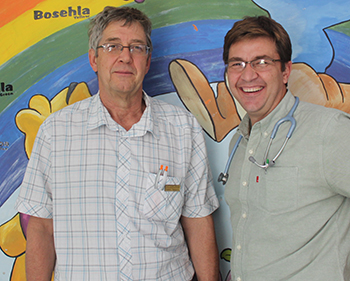
Prof David Stones and Dr Jan du Plessis of the
University of Free State’s paediatric oncology ward
are helping little lives, one patient at a time.
Photo: Nonsindiso Qwabe
Of 23 paediatric oncology specialists nationally, Prof David Stones and Dr Jan du Plessis of the University of Free State are the only ones in the province.
Committed to giving holistic care to their patients, the two doctors specialise in all types of childhood cancers, the most common being leukaemia, brain tumour, and nephroblastoma.
They describe the childhood malignancy as a lethal disease, unpredictability being its harshest trait. “With cancer, you can just never know. It precipitates and multiplies, and leads to the failure of other organs. You can just always hope, and keep trying,” said Du Plessis.
The paediatric oncology unit of the Universitas Academic Hospital, their unit, is the liveliest floor in the entire building. It is also the third busiest in South Africa, serving a demographic that spans the Free State and Northern Cape, as well as parts of North West, Eastern Cape and Lesotho.
Each year, the unit receives more than 100 new childhood cancer patients. In 2015, the unit had 113 newly diagnosed patients, an increase from 93 in 2014.
Lack of knowledge poses a serious challenge
According to the two experts, the lack of insight and awareness of the disease remain a big challenge to fighting it. “It is frustrating. Parents and family members don’t know anything about it. Nurses and doctors aren’t always clinically trained to pick up the early warning signs. By the time a diagnosis is made, life and death is on a 50% margin,” Stones said.
Poverty, a lack of resources, overcrowding and a range of health issues are other factors that have a profound effect on the diagnosis and treatment of the disease.
Making a contribution that will last
With a desire to see an improvement on life outcomes in the health sector, the team is focusing on educating the country’s doctors of tomorrow. Their unit is the only one in the country that actively involves medical students in an oncology unit, giving them practical experience and exposure to the individual cases each patient presents. They have also produced a substantial amount of research literature on childhood malignancies in South Africa as a developing country.
Driven by passion to see a better South Africa
The doctors are passionate about the work they do, and remain hopeful there will be a change in the incidence of childhood cancer not just in decreased levels of the disease, but also in the overall state of well-being of young South Africans.